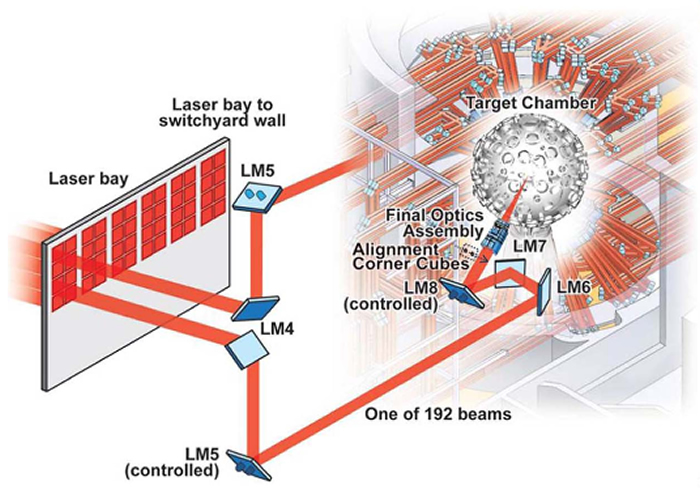Papers and Presentations - 2016
November
A Streamlined Approach to Aligning NIF’s Lasers
NIF’s 192 laser beams are automatically aligned using an image-based automated alignment system that enables NIF to execute multiple target shots per day. In a process that takes 30 minutes to complete, up to 5,407 mirrors are adjusted using more than 3,000 software control loops. The control loops align the beams to the NIF Target Chamber center to within a 50-micron accuracy.
An important part of the alignment process is centering the beams through the second- and third-harmonic generating crystals in the final optics assembly (FOA); this process employs two retro-reflecting corner cubes as centering references for each beam. Due to systematic differences in optical beam paths and thermal effects, variation in source illumination and systematic beam changes over time in the FOA corner-cube images can lead to a reduction in accuracy as well as increased convergence durations for the template-based position detector.
In an article in a special issue of Applied Optics on information optics published online on Nov. 8, LLNL researchers described a streamlined approach to maintaining and developing optimum position detection for FOA corner-cube images that maintains the corner-cube templates and guarantees stable position estimation. The new method significantly reduces the time required to align the lasers over the course of a year. In addition, the reduction in mechanical movement improves the reliability and longevity of many NIF hardware components.
 Diagram of the LM5-LM8 motorized mirrors and corner cubes in the NIF final optics assembly.
Diagram of the LM5-LM8 motorized mirrors and corner cubes in the NIF final optics assembly. A composite made from a set of patterns from each beam is called a template or matched filter kernel. The templates are used to automatically align the NIF beams using a matched filter. The Applied Optics paper describes a systematic method of evaluating an existing template and producing a new template that improves the location estimates in the corner-cube images. The streamlined design process requires a finite number of steps and provides more accurate alignment position estimates when the improved templates are applied.
“This approach…demonstrates how the overall NIF alignment system is continually optimized in terms of operational performance,” the authors said. “The matched filtering technique described here could be applied to any position detection technique where the signal has spatial or temporal variability.”
Lead author Abdul Awwal was joined on the paper by LLNL colleagues Erlan Bliss, Gordon Brunton, Victoria Miller Kamm, Richard R. Leach, Jr., Roger Lowe-Webb, Randy Roberts, and Karl Wilhelmsen.



